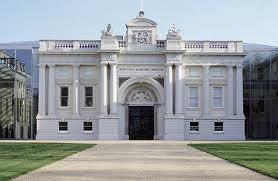
My university course recently took me to the National Maritime Museum & The Queen’s House in Greenwich where we had to create a trail through the sites. It was a lot more challenging than I’d anticipated as there are so many hidden stories. It’s the thing I love most about museums, getting to discover parts of history you knew nothing about and the reflection on your own life when you read about heroic conquests and the restrictions faced in times gone by. 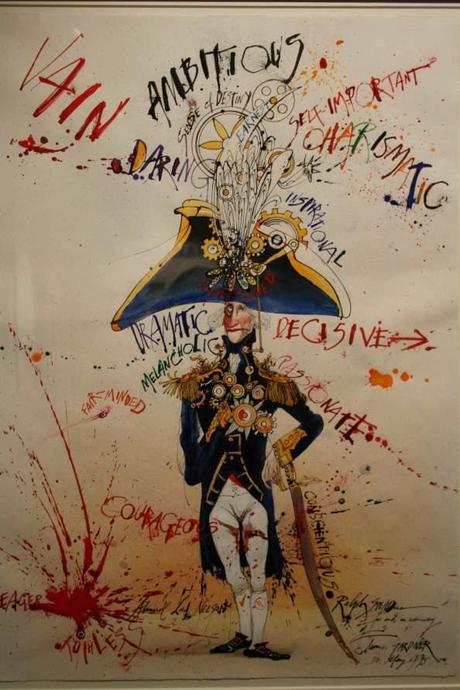 Ralph Steadman’s take on the national maritime hero Nelson shows his many facets. At the museum you can see Nelson’s coat, pictured above, complete with the bullet hole that killed him at the Battle of Trafalgar. Nelson is a fascinating character, one which I continued to read about after leaving the museum. He was considered an inspiring effective leader who took care of his men, he joined the Royal Navy when he was 12 years old and was one of their greatest strategists, known for his unusual tactics. I could write about this all day but lets journey through the museum…
Ralph Steadman’s take on the national maritime hero Nelson shows his many facets. At the museum you can see Nelson’s coat, pictured above, complete with the bullet hole that killed him at the Battle of Trafalgar. Nelson is a fascinating character, one which I continued to read about after leaving the museum. He was considered an inspiring effective leader who took care of his men, he joined the Royal Navy when he was 12 years old and was one of their greatest strategists, known for his unusual tactics. I could write about this all day but lets journey through the museum…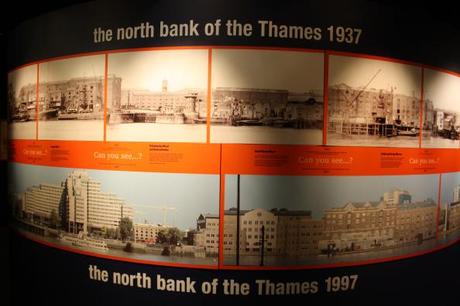 The Maritime London exhibition provides an interesting account of the city centred around the Thames, the thing that caught my attention the most is how the number of boats on the river has depleted over the years. There was a time when most trade was done by sea and boats/ships could hardly move on the Thames. For a captivating account of London, I’d recommend Julien Temple’s film Modern Babylon which captures the city using historical footage.
The Maritime London exhibition provides an interesting account of the city centred around the Thames, the thing that caught my attention the most is how the number of boats on the river has depleted over the years. There was a time when most trade was done by sea and boats/ships could hardly move on the Thames. For a captivating account of London, I’d recommend Julien Temple’s film Modern Babylon which captures the city using historical footage.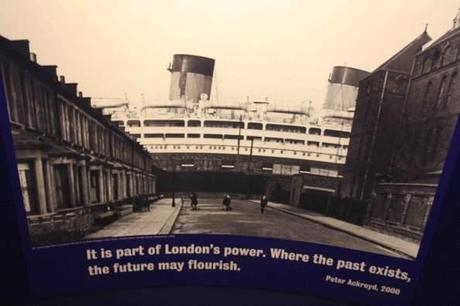 Can you imagine seeing that at the end of the street when you woke up in the morning? Weird
Can you imagine seeing that at the end of the street when you woke up in the morning? Weird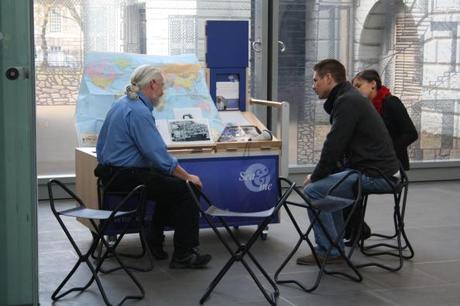 Hands down my favorite memory of the National Maritime Museum was speaking to Ian as a part of their ‘Me & the Sea’ stand. He had worked as part of the merchant navy when he was younger and some very exciting memories. Can you imagine being on a ship for 18 months? I certainly can’t. I was dying to ask what they did about women as he said there were no females on the ships, except people who brought their wives. He saw some exciting places, from the ship!
Hands down my favorite memory of the National Maritime Museum was speaking to Ian as a part of their ‘Me & the Sea’ stand. He had worked as part of the merchant navy when he was younger and some very exciting memories. Can you imagine being on a ship for 18 months? I certainly can’t. I was dying to ask what they did about women as he said there were no females on the ships, except people who brought their wives. He saw some exciting places, from the ship! 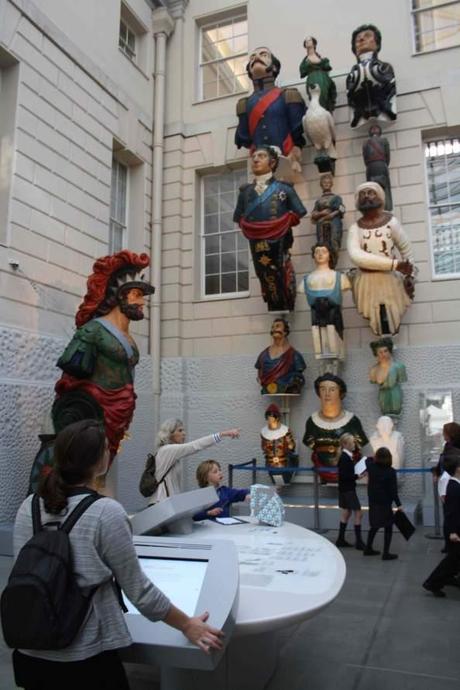 There is an extremely impressive display of figureheads. These are the wooden decorations you have at the prow of the ship to warn off evil. The differences in them are funny, it got me thinking what I’d have. Maybe my dad, he can be scary when he wants to be
There is an extremely impressive display of figureheads. These are the wooden decorations you have at the prow of the ship to warn off evil. The differences in them are funny, it got me thinking what I’d have. Maybe my dad, he can be scary when he wants to be 
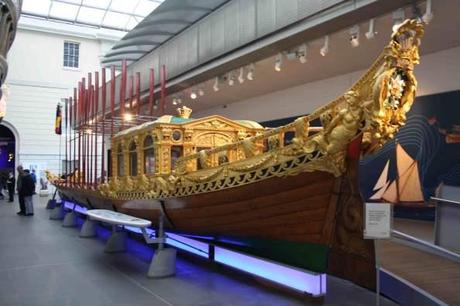 Prince Frederick’s Barge was built in 1732 by John Hall and William Kent and was in use for royal occasions until 1849. It is accompanied by images of the performance of Handel’s Water Music, a work which was performed at a party on the river Thames attended by King George I on 17 July 1717 . While this barge is not the one used for the 1717 river party, it is a great example of an 18th century English Royal barge.
Prince Frederick’s Barge was built in 1732 by John Hall and William Kent and was in use for royal occasions until 1849. It is accompanied by images of the performance of Handel’s Water Music, a work which was performed at a party on the river Thames attended by King George I on 17 July 1717 . While this barge is not the one used for the 1717 river party, it is a great example of an 18th century English Royal barge.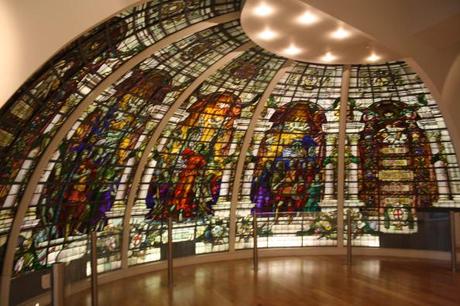 GASP! This huge glass is a memorial to the 60 members of the Baltic Exchange, an independent source of maritime market information, that lost their lives during World War I. It has been restored after the exchange was hit by a bomb in 1992. It is over 3 meters high and is a fusion of classical and religious symbolism, which celebrates the heroism and triumph of war.
GASP! This huge glass is a memorial to the 60 members of the Baltic Exchange, an independent source of maritime market information, that lost their lives during World War I. It has been restored after the exchange was hit by a bomb in 1992. It is over 3 meters high and is a fusion of classical and religious symbolism, which celebrates the heroism and triumph of war. 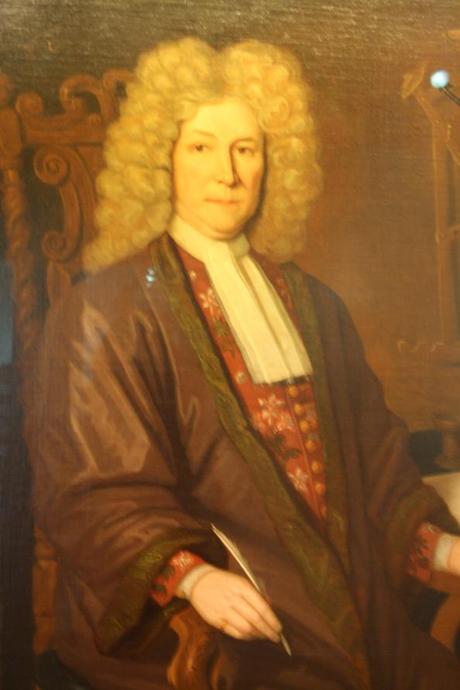 The Traders Gallery gives an account of the East India Company, which could be described as the worlds first corporation. Pictured above is Captain Robert Knox, a captain in the East India Company, the National Maritime Museum describes him as the Real Robinson Crusoe. The following text is taken from the NMM’s website ‘Knox was the son of Robert Knox, a sea-captain in the service of the English East India Company. In 1659 Robert senior was returning home from his post with the Company at Fort St George (Madras), accompanied by his son, when a storm forced their ship, the ‘Ann’, into Cottier Bay, Ceylon. They were taken prisoner with the rest of the crew by the Sultan of Ceylon and Knox senior died of malaria in captivity. After twenty years, during which he survived by knitting caps, hawking goods and lending rice and corn, young Robert escaped with one companion in 1679 and reached Arippu, a Dutch settlement on the north-west coast of the island. The following year he joined the East India Company and in turn served as a sea-captain until he was dismissed the service in 1694. In revenge he took command of an interloping trading vessel, the ‘Mary’, and he died a wealthy bachelor in London. In 1681 Knox also wrote an account of his experiences, ‘An Historical Relation of the Island Ceylon, in the East-Indies’, accompanied by engravings showing the inhabitants, their customs and agricultural techniques. In 1689, it was from him that Robert Hooke, Secretary of the Royal Society, learnt of the existence of ‘ganga’, ‘a strange intoxicating herb like hemp’, of which Knox gave him seeds and on which Hooke addressed the Society that December. This was the first English report of ‘ Indian hemp’ or cannabis.’
The Traders Gallery gives an account of the East India Company, which could be described as the worlds first corporation. Pictured above is Captain Robert Knox, a captain in the East India Company, the National Maritime Museum describes him as the Real Robinson Crusoe. The following text is taken from the NMM’s website ‘Knox was the son of Robert Knox, a sea-captain in the service of the English East India Company. In 1659 Robert senior was returning home from his post with the Company at Fort St George (Madras), accompanied by his son, when a storm forced their ship, the ‘Ann’, into Cottier Bay, Ceylon. They were taken prisoner with the rest of the crew by the Sultan of Ceylon and Knox senior died of malaria in captivity. After twenty years, during which he survived by knitting caps, hawking goods and lending rice and corn, young Robert escaped with one companion in 1679 and reached Arippu, a Dutch settlement on the north-west coast of the island. The following year he joined the East India Company and in turn served as a sea-captain until he was dismissed the service in 1694. In revenge he took command of an interloping trading vessel, the ‘Mary’, and he died a wealthy bachelor in London. In 1681 Knox also wrote an account of his experiences, ‘An Historical Relation of the Island Ceylon, in the East-Indies’, accompanied by engravings showing the inhabitants, their customs and agricultural techniques. In 1689, it was from him that Robert Hooke, Secretary of the Royal Society, learnt of the existence of ‘ganga’, ‘a strange intoxicating herb like hemp’, of which Knox gave him seeds and on which Hooke addressed the Society that December. This was the first English report of ‘ Indian hemp’ or cannabis.’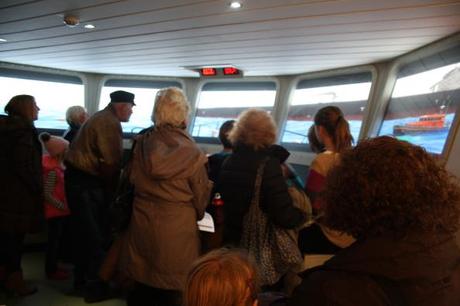 You too can have a go at captaining your own ship in this huge interactive, this is connected to the children’s gallery which is fantastic. It’s a very child-friendly place with lots of things to play with and learn.
You too can have a go at captaining your own ship in this huge interactive, this is connected to the children’s gallery which is fantastic. It’s a very child-friendly place with lots of things to play with and learn.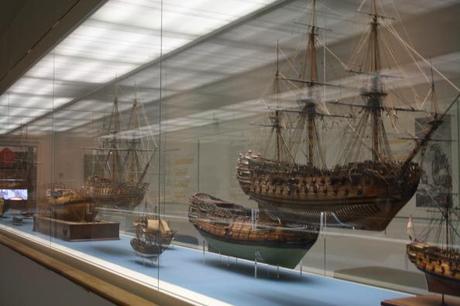 I loved the Ship Models, they have over 1000 in their collection, with just a handful on display. The detail is outrageous, its almost worth visiting just to see these.
I loved the Ship Models, they have over 1000 in their collection, with just a handful on display. The detail is outrageous, its almost worth visiting just to see these.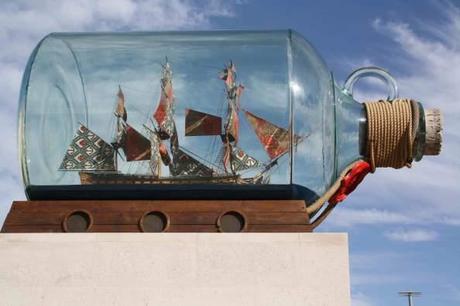 Depending which entrance you go in Yinka Shonibare‘s Ship In A Bottle is on display on a plinth outside the Sammy Ofer Wing. Originally made for the fourth plinth in Trafalgar Square, it is a 1:30 scale model of Nelson’s ship the HMS Victory. Shonibare has an interesting body of work, he is a British-Nigerian artist living in London and explores colonialism with the contemporary context of globalism. You can see the sails are made of ‘African’ fabrics, which he actually buys at Brixton market.
Depending which entrance you go in Yinka Shonibare‘s Ship In A Bottle is on display on a plinth outside the Sammy Ofer Wing. Originally made for the fourth plinth in Trafalgar Square, it is a 1:30 scale model of Nelson’s ship the HMS Victory. Shonibare has an interesting body of work, he is a British-Nigerian artist living in London and explores colonialism with the contemporary context of globalism. You can see the sails are made of ‘African’ fabrics, which he actually buys at Brixton market.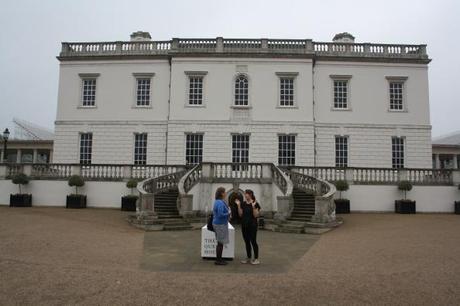 Just next door is The Queen’s House, which is architecturally important, it it the first example of classical architecture in Britain and was designed and built by Inigo Jones and commissioned by Anne of Denmark, wife of James I (reigned 1603–25).Traditionally he is said to have given the manor of Greenwich to Anne in apology for having sworn at her in public, after she accidentally shot one of his favorite dogs while hunting in 1614. One step up from a bunch of flowers…
Just next door is The Queen’s House, which is architecturally important, it it the first example of classical architecture in Britain and was designed and built by Inigo Jones and commissioned by Anne of Denmark, wife of James I (reigned 1603–25).Traditionally he is said to have given the manor of Greenwich to Anne in apology for having sworn at her in public, after she accidentally shot one of his favorite dogs while hunting in 1614. One step up from a bunch of flowers…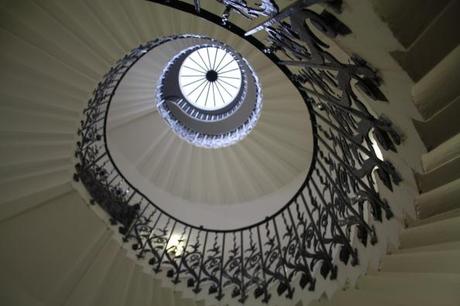 The Tulip Stairs are an iconic design, they are the first geometric self-supporting spiral stair in Britain. I almost felt guilty walking on them!
The Tulip Stairs are an iconic design, they are the first geometric self-supporting spiral stair in Britain. I almost felt guilty walking on them!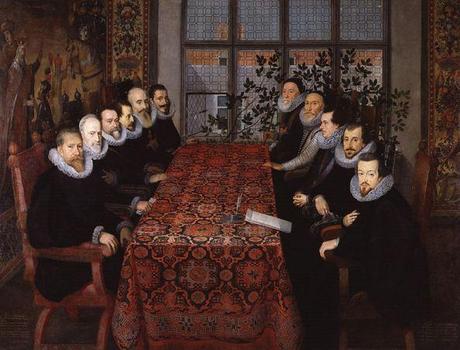 The Queen’s House is home to the Royal Museums Greenwich art collection, and every picture tells a story. To some people it may look like gloomy old paintings but the history that comes with some of the images is astounding, its all about finding the story. The painting abois call The Somerset House Conference, there are several copies of this image, all done in oils, one is held at the National Portrait Gallery. This group portrait commemorates the peace treaty between England and Spain in 1604 which brought an end to a war which had dragged on for almost twenty years. Its the first known painting of the signing of a treaty, so speaks of its historical significance. As you walk into the room you should look at the eyes of the delegates and the table, they follow you as you walk – its pretty creepy.
The Queen’s House is home to the Royal Museums Greenwich art collection, and every picture tells a story. To some people it may look like gloomy old paintings but the history that comes with some of the images is astounding, its all about finding the story. The painting abois call The Somerset House Conference, there are several copies of this image, all done in oils, one is held at the National Portrait Gallery. This group portrait commemorates the peace treaty between England and Spain in 1604 which brought an end to a war which had dragged on for almost twenty years. Its the first known painting of the signing of a treaty, so speaks of its historical significance. As you walk into the room you should look at the eyes of the delegates and the table, they follow you as you walk – its pretty creepy.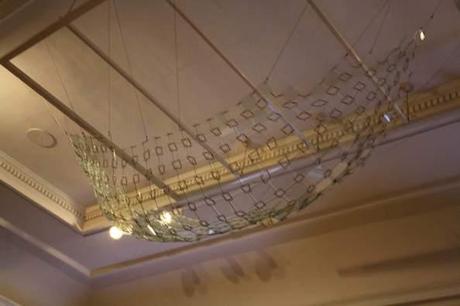 Absentee by Rosie Leventon, was commissioned by the National Maritime Museum as part of its New Visions contemporary art programme. It is a ghostly recreation of the Implacable, a famous French ship that fought in the Battle of Trafalgar and was later captured by the Royal Navy.
Absentee by Rosie Leventon, was commissioned by the National Maritime Museum as part of its New Visions contemporary art programme. It is a ghostly recreation of the Implacable, a famous French ship that fought in the Battle of Trafalgar and was later captured by the Royal Navy.
There is a lot to see there in Greenwich, you can also visit the Royal Observatory and the Cutty Sark, but I’ll save that for another day! I’d highly recommend at least a day out there…
Entry Fee: FREE
Location: Park Row, London SE10 9NF
